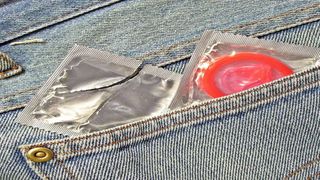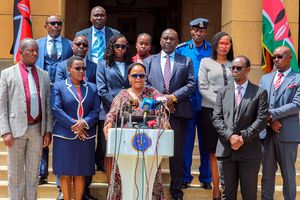
Stigma and lack of free condoms have led to a drop in their usage.
| File | Nation Media GroupNews
Premium
Stigma, unavailability dent condom use
Stigma and lack of free condoms have led to a drop in their usage, data released yesterday, February 13 shows.
According to the data from the National Aids Control Council released last year in November, the uptake of condoms in the country is worrying. The usage stands at 20 condoms per man per year compared to the World Health Organisation (WHO) target of 40 condoms per man per year.
As the World Celebrates the International Condom Day today, health experts are worried that most countries in Africa, Kenya included will not meet the UNAIDS condom use targets of 95 per cent coverage by 2030.
Kenya has since started a conversation on condom usage and the need to take stock of some of the challenges being faced by the users aiming at achieving the 80 per cent usage by 2030.
“Use of condom as a preventive measure would go a long way in reducing the cost that arises from the treatment of HIV related infections, but most people are not using the commodity,” said Dr National Aids Control Council CEO Ruth Masha.
“We should address the use of condom more to our young ones. We have to disrupt the norms and the cultures where we have to call it as it is. With this we are going to create awareness on this commodity,” she said
In Kenya, gender-related fears, stigma, cultural and religious beliefs, cost, donor dependency unavailability of free condoms amongst others, hinder the adoption of condom usage.
Experts have blamed the low usage unavailability of condoms, on heavy taxation of the commodity in a country where free condom programmes are mainly donor-funded.
“They are not getting condoms in their friendly clinics when they need them, and they are not able to buy them because they do not have the money and with this, they end up not using the. We are letting them down as a country. We really need to change this conversation,” he said.
Latest data from the National Aids Control Council indicates persons aged between 15 and 24 years have about four times HIV prevalence among females as compared to males. The data further shows 61 per cent of all new HIV infections are being recorded among adolescents and young people in Kenya.
The programme that provides free condoms, an important component of Kenya’s HIV prevention campaign, depends entirely on donor support to procure the commodities.
The Kenyan government distributes approximately 180 million free condoms annually and the programme is funded by the Global Fund and the United Nations Population Fund (UNFPA).
The country needs 455 million condoms annually, but the government is able to provide only 1.6 million per month.
Last year, about 20 million condoms were distributed to Kenyans for free under a programme funded by the Global Fund and the United Nations Population Fund (UNFPA).
However, for the one year, HIV patients in various groups have been discussing the shortage of condoms in the country with some of them distributing the little they have to the community and to the facilities around.
Dr Samuel Kinyajui, the Country Director, AIDS Healthcare Foundation said last distribution of free condoms to facilities was 2018 and most facilities are not stocking the free condoms.
This is exposing vulnerable groups such as teenagers, who cannot afford to buy the commodity, to the risk of unwanted pregnancies, HIV/Aids and STIs.
“The sure branded condoms which according to me as always the best have been out of stock for some time now and this has really affected the people who really depended on them to protect themselves
Dr Kinyanjui attributed the stock-out to the government demanding taxes on the donations.
“But honestly, why do we have to tax commodities that are given to us for free? If we continue like this, we are going to have more problems because as a country we are not able to fund our health system. We should decide whether we want condoms or taxes because once the donors withdraw, then we are doomed,” Dr Kinyajui said.
Mr Nelson Otwoma, the executive director of the National Empowerment Network of People Living with HIV/AIDS confirmed that one way Kenyans can protect themselves is to supply them with the free condoms.
Some men also believe that condoms inhibit sexual pleasure, while others believe they have side effects after use with some men not willing to go to supermarkets and pharmacies to buy them.
Mr Edwin Akach, a chemist attendant, says both men and women find it hard to purchase condoms with some preferring to write it down for them while others just pointing and not callig out the name condom.
“They use coded names like ‘gumboots’, ‘socks’, ‘umbrella’ and ‘polythene’,” says Mr Akach.
However, for Millicent Ambani, in Kenyan set up, a woman buying a condom is perceived as loose.
“I would rather tell the person to come with a condom than me walking a supermarket to buy one,” she says.
Dr Dismas Okech, a HIV researcher said that contrary to the stigma that surrounds the purchase of condoms, knowledge on proper use is not always adequate.
“Discussing condoms is a taboo. This is why most people shy away from buying and even asking for condoms when they are in need. These are some of the factors contributing to low condom usage in the country,” Dr Okech said
Shortage of the commodity also contributes to the low usage of condoms in the country, Dr Okech added.
"Some Kenyans really depend on the government to provide free condoms at health facilities. When they do not find them in these facilities and they don’t have the Sh100 to buy a pack, they just do without it.
''This puts their lives and those of many others at risk,” the researcher explained.
“Some Kenyans depend on the government to provide free condoms in health facilities. When they do not find them they opt not to use them because they do not want to spend money on the commodities,” Dr Okech said.
The WCD is being marked at a time that Kenya is experiencing an acute shortage of free condoms with many public health facilities, hotels, offices and restaurants reporting lack condoms in their dispensers for the past one year.
“Buying a condom is not easy and at times you do not even have the money to purchase one. That is why free condoms are always placed on washrooms for easy access. Anyone who wants can just pick,” he said
“The others are available but the stigma and judging that comes with the condom is also driving away people more so the young ones. Let’s make protection easy.”





